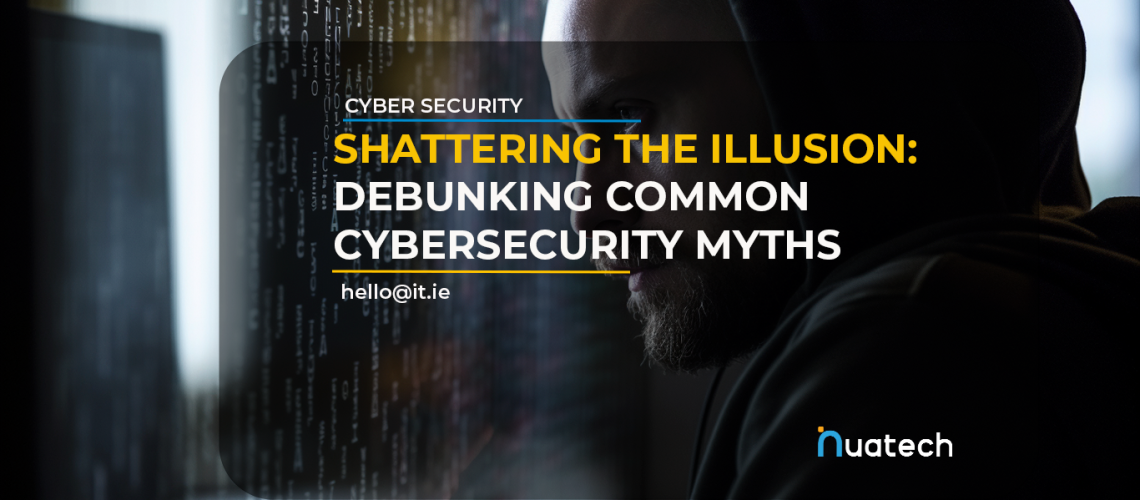

Imagine your sensitive data exposed, operations crippled, and customers outraged. This isn’t science fiction; it’s the harsh reality of a cyber-attack. In today’s environment, robust cybersecurity isn’t an option – it’s an imperative.
But navigating the world of cybersecurity can be confusing. Myths and misconceptions abound, leading to a false sense of security and, ultimately, vulnerabilities. This article serves as your myth-busting guide, debunking common misconceptions and empowering you to build a truly resilient defence.
Fact: Small businesses are very often targeted by cybercriminals because they may be viewed as having weaker security measures compared to larger corporations. In fact, small businesses are attractive targets because they hold valuable data and may serve as entry points to larger partner networks. Cyber incidents at large organisation tends to get more publicity, however, the European Agency for Network and Information Security (ENISA) reported in 2023 that 61% of data breaches in the EU related to SME’s.
Fact: While strong passwords are important, they are only one layer of security. Multi-factor authentication (MFA), regular software updates, and employee cybersecurity training are essential components of a comprehensive security strategy. The same ENISA report highlighted that over 80% of data breaches in the EU involve stolen or weak passwords.
Fact: Cybersecurity is a shared responsibility. Every employee plays a crucial role in maintaining security by following best practices, such as identifying phishing attempts and using secure networks. A culture of cybersecurity awareness across all departments significantly enhances overall protection. Statistics on the benefits of Cyber Awareness training highlights significant success rates in preventing phishing attacks by up to 90% and also show a large increase in the detection and reporting of incidents by employees.
Fact: Antivirus software is crucial but not infallible. Cyber threats evolve rapidly, and no single solution can offer 100% protection. A multi-layered approach, including firewalls, intrusion detection systems, and regular security audits, is necessary for effective defence. IBM reported in 2021 that companies with a multi-layered defence are five times less likely to experience a successful cyberattack.
Fact: While implementing security measures may require some adjustments, the cost of these changes is minimal compared to the potential losses from a data breach. Modern cybersecurity solutions are designed to be efficient and can often enhance operational efficiency by streamlining processes and protecting against downtime caused by attacks.
Fact: Cybersecurity is an ongoing process. Threats continually evolve, requiring regular updates to security systems and practices. Regular training, software updates, and security assessments are essential to stay ahead of potential vulnerabilities. The WannaCry ransomware attack in 2017, leveraging an unpatched Windows vulnerability, infected over 300,000 computers in 150 countries. Acronis Cyber Protection Report 2023 reported that 93% of successful cyberattacks exploit known vulnerabilities.
Fact: Many cyberattacks are designed to be stealthy, remaining undetected for long periods to gather as much information as possible. Continuous monitoring and anomaly detection are critical components of a strong cybersecurity strategy to identify and mitigate threats early.
In 2021, the Irish Health Service Executive (HSE) was the victim of a well-publicised ransomware attack. The timeline of this attack was as follows. On March 16th, an unsuspecting HSE employee receives malicious email. On March 18th, the employee opens the email and unknowingly downloads malware to the HSE network. Over several weeks the attackers exploit the initial breach to gain further access within the network. On May 14th, eight weeks after the email was received, the Conti ransomware was deployed.
So, there you have it! You’ve just debunked seven common cybersecurity myths, empowering yourself and your organisation to make informed decisions. Remember, cybersecurity isn’t just about technology; it’s about awareness, vigilance, and collaboration.
Stay informed: Threats evolve constantly, so stay updated on emerging risks and best practices.